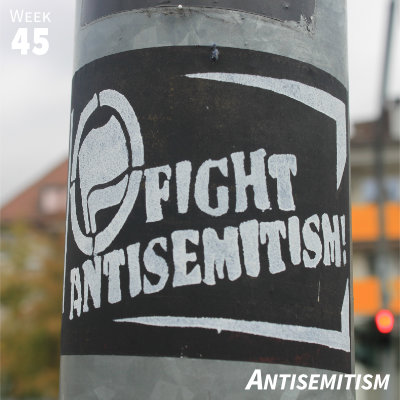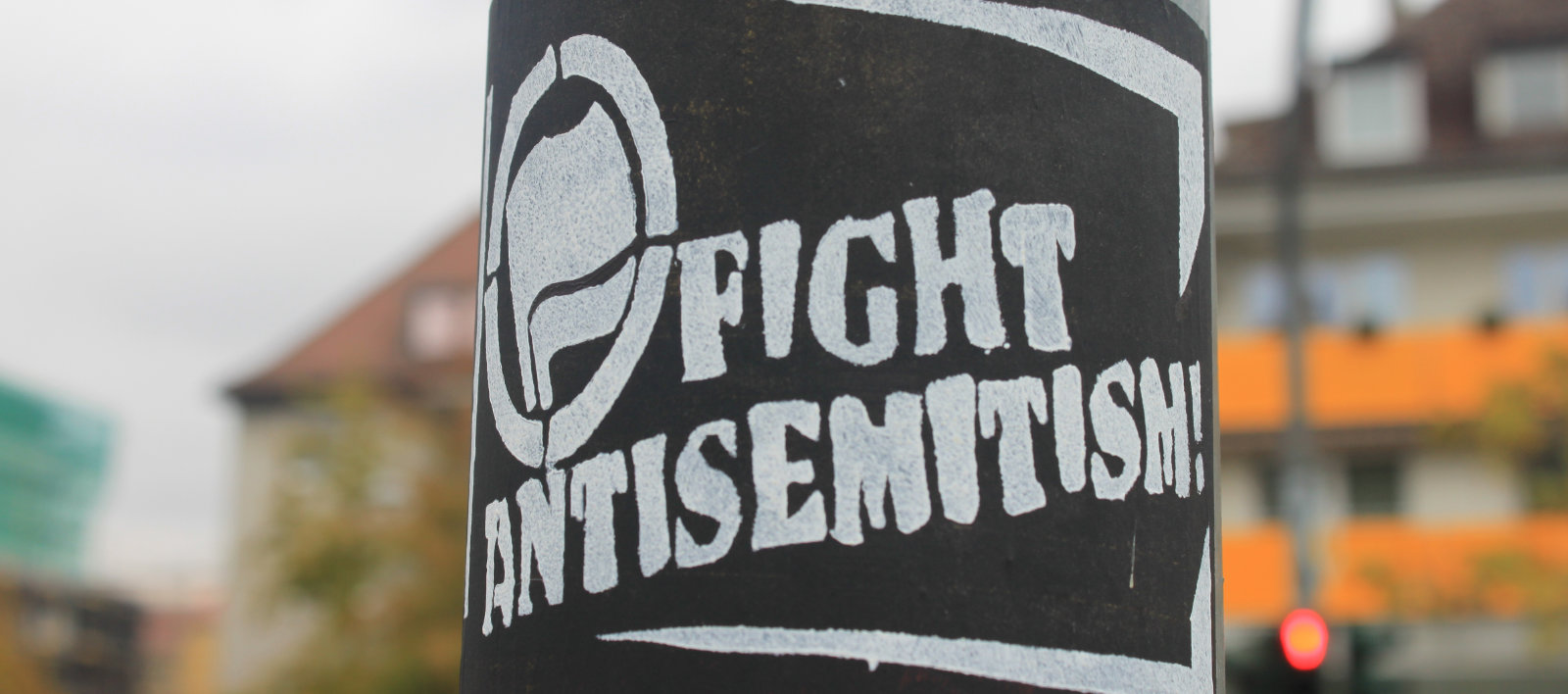Week 44: Antisemitism

Across Europe, November 9 is the International Day Against Fascism and Antisemitism. As a nonviolent movement dedicated to achieving peace for all people in Palestine, it is critical that the Kumi Now community understands and fights all forms of hate, including antisemitism. As we work for justice for Palestine, let us also remember and renew our call for the elimination of antisemitism in all its forms. Here’s what you need to know about antisemitism and what you can do so that together we can rise up.
Topic: Antisemitism
To understand the genesis of Zionism, the State of Israel, and the subsequent Palestinian Nakba, it is crucial to understand modern antisemitism. However, antisemitism is not solely a modern invention. Antisemitism, a word that only emerged in the 19th century but has come to describe a much longer history of oppression, has taken on many different forms throughout history, including religious, socio-cultural, economic, and political antisemitism. With the emergence of Christianity, Jews were attacked as the “stubborn enemy.” Socio-cultural prejudice was largely based on the theological-religious differences between Jews and the people of the ruling empire in which they lived. This led the two communities to live isolated from each other, with differences in diet and ritual schedules. Economic discrimination against Jewish communities took multiple forms and included the restriction of land holding rights and job opportunities. It also included damaging stereotypes of Jews as controllers of wealth and abusers of the common people. Political discrimination also arose when Jews were viewed as threats to national identity and security.
In order to discuss antisemitism within Palestinian communities, we must understand its history. The following section is not comprehensive but attempts to build a framework for understanding how and where antisemitism arose, as well as how it has changed and spread over time. This section will focus on antisemitism both in the east and in the west, as well as within Christian and Muslim theology, scripture, liturgy, and tradition.
During the early years of the Roman Empire, religion formed a central pillar of government. The Roman Senate declared Julius Caesar as divine on January 1, 32 BCE, and subsequent emperors demanded to be worshipped as gods on Earth. This created serious problems for Jewish communities who were prohibited by the commandments from worshipping other gods.
The fourth-century adoption of Christianity as the official religion of the Roman Empire meant that empowered Christians could transform their attitudes towards Jews into codes of legislation. Jews were now officially marginalized and discriminated against. They could not hold official posts in the administration; they were forbidden from spreading their religion; they could not build new places of worship or renovate existing ones; they were banned from owning land and thus were limited to certain professions that did not require land ownership, such as money lending and tax collecting. Anti-Judaism evolved further in the Middle Ages in Europe as Jews were identified as enemies of Christian society. They were even required to wear clothing distinguishing them from others so that they were visible from a distance.
The various Crusades throughout Europe and the Mediterranean unleashed great violence against Jewish communities in Europe as Jews were perceived to be as much an enemy to Christianity as Muslims. Jews were the proximate non-Christians–more prevalent in Europe than Muslims–and were held responsible for the crucifixion of Jesus. Jewish communities suffered the violence of hostile Christians.
In the wake of the Crusades, more myths about Jews were propagated. They were accused of murdering the most Christlike of believers—children—who, according to popular myths, were kidnapped and their blood used to bake matzah, the ritual bread eaten on Passover, an accusation termed “blood libel.” In other places, Jews were accused of desecrating the Blessed Sacrament–the body and blood of Christ. During the Black Death–the bubonic plague which spread through Europe killing thousands–Jews were falsely accused of having poisoned the water sources. Finally, beginning at the end of the thirteenth century, Jews were expelled from country after country. The most dramatic expulsion was that from Spain between 1391 and 1492. In other places, Jews were segregated into separate areas of cities called ghettos. In the fourteenth century, the Church in France ordered the burning of Jewish religious books, including many volumes of the Talmud, which they claimed were the religious texts that defamed Jesus and prevented Jews from accepting Christianity. This practice was repeated in other countries. Discriminatory attitudes towards Jews were an integral part of society in many places.
Christian anti-Judaism was directed against Jewish belief and practice. It firmly held that the Jewish religion should have disappeared with the coming of Christ and the preaching of the Gospel. Jews, who did not become Christians willingly, should be propelled toward the Church, even if this meant using force. Martin Luther, German professor of theology, and a seminal figure in the Reformation, who in his hatred-filled later writings recommended persecution against Jews, had hoped that reforms of the church would compel Jews to convert, saying: “We ought, therefore, not to treat the Jews in so unkindly a spirit, for there are future Christians among them, and they are turning every day.” Rather than being an example of support for Jews, this ideology is an example of anti-Judaism, as it only gives rights, protection, and dignity to the Jewish people based on the basis of their future conversion to Christianity.
The only way Jews could escape the pressure and sporadic violence was by converting and integrating into the Christian community. In this way, many were forced into conversion. However, Christians began to suspect that Jewish converts were continuing to practice Judaism secretly. The inquisition did not just question converts of “purity of blood” about their religious practices, suspecting that in secret they were maintaining an allegiance to the faith of their forefathers. Those judged of having converted while maintaining Jewish belief or practices were burnt at the stake.
In 1789, the French Revolution overthrew the old regime in France and instituted a separation between religion and state. The Church lost much of its social and political power, and religious faith and practice was relegated to the private sphere. The Revolution preached the values of equality, liberty, and fraternity, and in this spirit, Jews were invited to leave their segregated neighborhoods and integrate as citizens with equal rights. Napoleon, conquering large parts of Europe, brought these values to all parts of his Empire. Slowly but surely, Jews were emancipated in other parts of Europe, although this emancipation came to Russia and other parts of Eastern Europe much later.
As the socio-political impact of anti-Judaism began to fade in Europe with the liberation and integration of Jews into society, a new type of hostility towards Europe’s “internal other,” the Jewish people, was born. This was racial antisemitism.” Ideologies of “race” became an important part of socio-political discourse in the second part of the nineteenth century, and a school of thought called eugenics emerged. Eugenics focused on the creation of genetically pure races by creating hierarchies of superior and inferior races. As newly formed national groups struggled for independence from the great multi-ethnic empires of Europe, some defined the Jewish people as foreign to the social fabric and even as an enemy to the welfare of the nation, of being traitors and foreigners. Jews were perceived as being more faithful to one another across national boundaries rather than to their fellow citizens, or they were seen as serving the interests of transnational empires, which they supposedly controlled through their banks and moneylending. A forged document claiming to be written by Jewish elders, The Protocols of the Elders of Zion, proliferated false theories about plans for Jewish global domination. These theories gained traction in politically far-right circles, and were used to justify antisemitic policies of exclusion and, ultimately extermination. Tragically, they were used by individuals and groups in many different parts of the world to explain their theoretical dangers caused by Jews to the rest of society.
Genetics, biology, and evolution were mobilized to prove the essential difference between Jews and other Europeans. Theories of racial hierarchies placed Jews below other Europeans, sometimes classifying them as a subhuman race. Under this racial theory, Jews would always be Jews, even after baptism, and they did not belong to the European racial fabric.
New false allegations about Jewish plots to take over Europe or the world evolved. Jews, especially bankers and politicians, were accused of infiltrating state mechanisms to further their aims. They were falsely charged with seducing pure European women in order to sully the purity of the nation. In Germany, Jews were blamed for “stabbing the nation in the back,” working behind the scenes to cause Germany to lose the First World War. Antisemitic ideologues began to develop new measures to rid Europe of the Jewish presence, through expulsion, impoverishment, eventually leading to mass genocide.
Adolf Hitler was only one among many European antisemites, but his appealing blend of German nationalism and radical antisemitism contributed to his rise to power in Germany in 1933 and the German conquest of much of Europe. He and his collaborators in the Nazi regime were able to wipe out more than one-third of the people of Jewish faith in the world at that time. The Nazis’ “Final Solution” was a meticulously planned genocide and stands out as the most defining evil of the 20th century. In addition to the six million Jews and millions of others –Roma and Sinti, homosexuals, Jehovah’s Witnesses, Communists, etc.–murdered, millions more were dispossessed, uprooted, and terrorized.
Before the Shoah, the Hebrew term for The Holocaust, many Jewish Europeans had sought integration in their countries of birth. They had hoped that the processes of integration that had begun in the aftermath of the French Revolution would bring to fruition the dream of liberty, equality, and fraternity. Many Jews had integrated to such an extent that they had lost any sense of difference from their neighbors. The Shoah shattered those newfound feelings of safety and inclusion in European society.
After the Shoah, overt antisemitism lost its legitimacy in many Western societies. No longer could European politicians evoke antisemitism without harsh condemnation. It was socially unacceptable. However diminished, antisemitism did not vanish.
Nor did it continue to fade over time. Sadly, antisemitism has been increasing in recent years. And those advocating for Palestine are often, rightly or wrongly, accused of antisemitic thoughts and statements. But the two need not, and must not, be linked. We must counter antisemitism in all its forms, especially as we advocate and organize for the rights and dignity of Palestinians. It would be hypocritical to call for the liberation of one people while ignoring the hatred aimed at another.
Kumi Now does not have all the answers, nor could we fit them in a short essay if we did. We do not believe it is possible to read a one-page summary of antisemitism and say we’ve learned about it and can now move on. We need to spend time to deal with antisemitism and confront our weaknesses as individuals. Therefore, throughout the week we will encourage you to study the Sabeel document on antisemitism and invite you to engage in a conversation about it. And we will share and publish stories and essays about countering antisemitism and what you can do to help.
Story: from “Americans at Yad Vashem” by Amanda Hawkins
One night in Lent a representative
from the Muslim congregation came
to talk to the people of a church.
The imam said forgiveness
is not the same
as reconciliation.
I was teaching writing via immigration laws.
The students argued languages.
The candidates argued walls.
The imam asked the people:
What communities live underground?
Whom don’t we talk about or see?
Whom are we silencing?
. . .
At the museum we saw the names written.
We heard the names through speakers in the walls.
We saw the faces spiraling up.
For once we,
the Americans at Yad Vashem,
did not talk.
From “Americans at Yad Vashem” by Amanda Hawkins, an American poet holding her M.A. in Theological Studies. Published by Poets.org.
Kumi Action
Opposing antisemitism needs to be a worldwide action, so start at home. Do you know where the closest synagogue or Jewish center is to your home? Have you been there? Or, conversely, have you ever brought a non-Jewish friend to your synagogue or Jewish center?
- Make it a point this week to reach out and make these connections:
- Visit a synagogue (or invite a visitor).
- Attend a class, prayer, or celebration at a synagogue.
- Have coffee with the rabbi or other leader and have an informal discussion of antisemitism in your area.
- Share the video of this poem on social media, along with an explanation of how you are reaching out against antisemitism.
- Learn more about Jewish Voice for Peace and share about their work on social media.
Encourage others to do likewise, and include a link to this page of the Kumi Now website along with the hashtags #Antisemitism, #KumiNow, and #Kumi45.
Literature: from “Reflection on Antisemitism” by Rev. Naim Ateek
No one should stand by when injustice is being inflicted on another human being, created in the image of God. We must all be ready to call out the injustice in all its forms and wherever it occurs—even if that injustice is arising from within our own communities or our own hearts.
In the current global context, prejudice takes diverse forms. It can look like antisemitism, Islamophobia, or racism against anyone because of their race, faith, ethnic background, skin color or sexual orientation. The Sabeel center recognizes this reality and must stand against it. Indeed, Sabeel must not waver in its commitment to seeking justice for the Palestinians in accordance with the demands of international law. In pursuit of this, however, we need to be aware that we are also susceptible to the sins of prejudice, hatred, and discrimination. I, therefore, hope that this document will serve as a criterion and a touchstone for reflection and study so that we can confront boldly the sin of antisemitism as well as all other forms and shades of racism and become agents of change, healing, and harmony for all segments of society.
As a liberation movement, Sabeel will do its best to hold accountable all those who are guilty of violence and unjust actions that breach human rights and international law. However, liberation will never be achieved while we ourselves are captive to racist thought or ideology. We remain committed to nonviolence, to justice, to love of God and neighbor. We also believe that faithful examination of our own prejudices will enable us to be in dialogue openly with people from all faiths and belief systems.
As Article One of the UNESCO Declaration on Race and Racial Prejudice says: “All human beings belong to a single species and are descended from a common stock. They are born equal in dignity and rights and all form an integral part of humanity.” And 1 John 4:20 states: “Whoever claims to love God yet hates a brother or sister is a liar. For whoever does not love their brother and sister, whom they have seen, cannot love God, whom they have not seen.” It is appropriate to quote the words of the World Synod of Catholic Bishops, “Action on behalf of justice and participation in the transformation of the world fully appear to us as a constitutive dimension of the preaching of the Gospel, or, in other words, of the Church’s mission for the redemption of the human race and its liberation from every oppressive situation. This should be our guide in all interactions with our sisters and brothers in humanity.
Therefore, as humans, as people of faith, and as Sabeel, we unequivocally reject, denounce, and repudiate all forms of hatred, discrimination, and racism; and commit ourselves to respect the dignity of every human being.
The Rev. Dr. Naim Ateek is a co-founder of Sabeel. The essay and this reflection are from a forthcoming document from Sabeel addressing antisemitism.
Additional Resources
Coming soon
Image Credits
Coming soon

